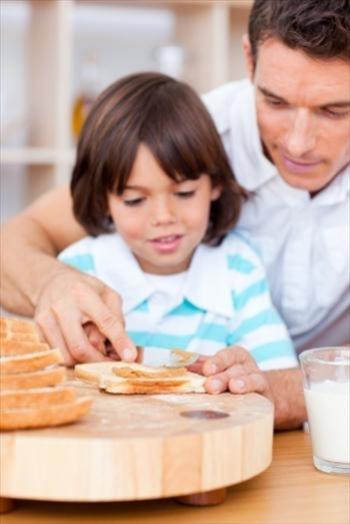Making toast
Duration/age

The sun has risen and it is time to get up. Are you hungry because it’s time for breakfast?
Will you have toast? If you’re having toast, are there different types of bread and spreads to pick from?
We have 3 different types of bread in the fridge. There is brown, white and multigrain. Which one do you want?
Yesterday you had butter and Vegemite on toast. Do you want the same today or something different?
Once your child has decided what kind or bread they want and the spread to go on top talk to them about how many pieces they would like to eat. Will it be more or the same as yesterday?
Once the toast has been cooked, encourage your child to put their own spreads on top. Talk to them about the order and how far to spread.
The butter will go on first so it can melt into the toast. Then the Vegemite goes on top of the butter.
I don’t like to spread to the edge of the toast. I want to be able to hold it without getting jam on my fingers.
Materials you will need
- Spoon
- Butterknife
- Toaster
- Bread
- Butter
Alternative tools
- Oven
- Grill
Skills this activity improves
Why does this matter?
As your child helps to spread the topping on their toast they are experimenting with placement, sorting and classifying objects.
As they spread the topping further across the toast your child is hearing and using the language of measurement. The language of measurement helps them to make decisions – how many pieces of toast do we need to make, how long will the toast take to cook, what size will we cut the toast into?
What does this lead to?
As your child spreads the topping they are exploring place and space, using and developing the small muscles in their hands and fingers and developing hand dominance (left hand vs right hand).
Hand dominance and control is important as it enables children to write for extended periods of time and to create small detailed pictures. If a child has not developed good hand control they will tire quickly when writing, use their shoulder to move the hand rather than the wrist and will find it difficult to create small connected letters.
Language to use
- Bread, slice, toast
- Brown, multigrain, white, rye
- Knife, plate, toaster, grill, chopping board
- Topping, spread
- Vegemite, jam, butter, peanut butter, honey, cheese
- Piece, slice
- Top, bottom, middle, edge
- Shape, square, triangle, rectangle
- Quantity, number, amount, one, two, three, four, more
- Big, little, small, large
- Cooked, raw, fresh
Questions to use
- How hungry are you today?
- How many pieces would you like?
- Which spread do you put on first?
- Can you have more than one spread?
- Can you toast all types of bread?
- Can you put the spread on the bread before you toast it?
Useful tips
- You might also like to take a look at the Let's make sandwiches activity.
- Remember to talk to your child in your home language.
More ideas
You could make toasted sandwiches for breakfast.
Variation by age
Three to five year olds
- Make a storybook about what your family likes to eat for breakfast.
Questions to ask
- Can you only eat toast at breakfast time?
- Can you eat other things for breakfast?
- Where does jam come from?


